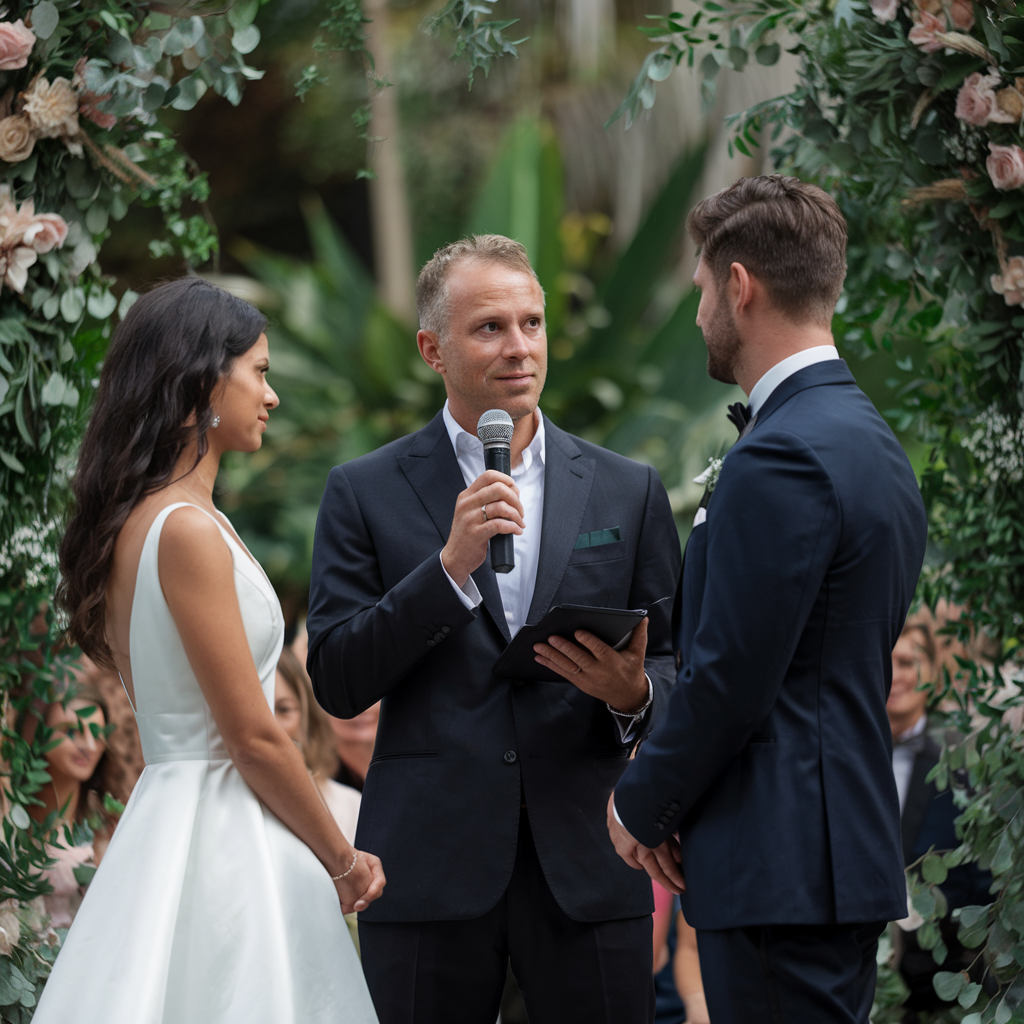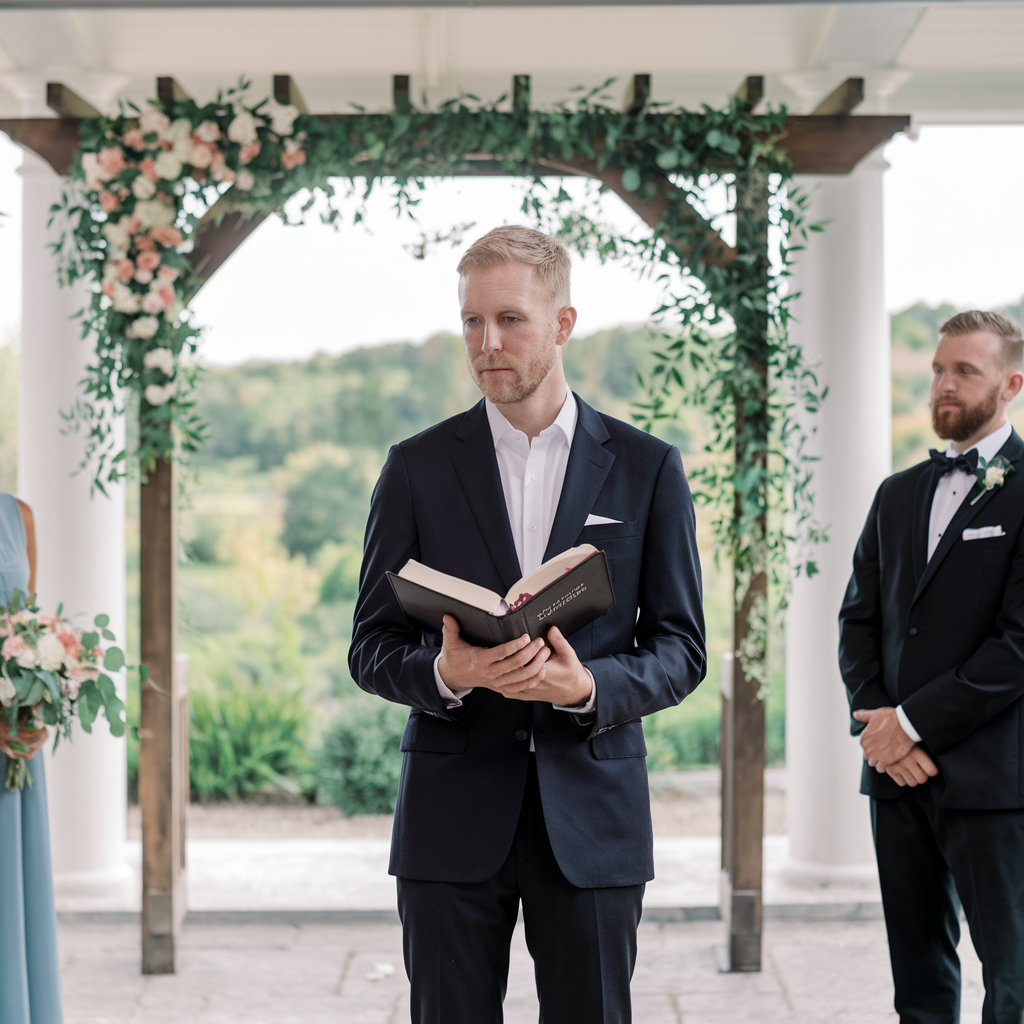Key points
• Prepare legally to ensure the wedding is valid. Check what papers are in the right state as some places ask for an ordination certificate while others need a license or other special forms.
• Work with the couple to create a ceremony that feels like them. Ask what parts they want to include – vows, rings, readings, or special bits. Help them pick words that sound like their real voices.
• Practice the ceremony out loud before the big day. This helps feel more at ease when all eyes are on you. Go through the whole thing – where to stand, when to ask for rings, and how to end it right. Do a run-through the day before to catch timing issues that could have been awkward and detrimental to the event.
Contents
Understanding the Role of a Wedding Officiant

Being a wedding officiant at first can be confusing and difficult – but it was satisfying.
All eyes and ears are on them when a wedding officiant talks – this is not an easy job. It’s more than just saying the right words – it involves creating a space where love can become official.
Defining the responsibilities of an officiant
What does an officiant do?
They try to understand the couple’s history and vision together to craft a ceremony that fits them perfectly. They also guide everyone during the wedding rituals and help everyone with any issues that may arise – like an operator or a mechanic behind the scenes.
Legal requirements and considerations
There will be no valid and enforceable marriage if the legal requirements are not discussed and followed accordingly.
Some states may require ordainment, others call for county clerk registration, and some are left to accomplish the relevant paperwork where a representative is allowed.
Here are the three considerations before choosing an officiant:
- Are they legally allowed to officiate in that location?
- What documents do they require to complete?
- What’s the timeline for filing the marriage license?
Cultural and religious sensitivities
Traditions matter a lot when working with a couple of two different cultures. Jewish, Catholic, Hindu, and Baptist differ in terms of ceremonies and wedding rituals.
The key to respecting cultural sensitivity is to listen first. Ask the couple what tradition they want to keep and which tradition they will skip. Don’t make assumptions based on background – ask what’s important for them.
Some religious elements are performed by chosen people. If you cannot perform a particular ritual – get someone who can perform it for that part of the ceremony.
Preparing for the Ceremony

Being a wedding officiant is more than just showing up and reading. Their work begins in weeks or months as they need time to craft something special and well-suited for the couple.
Meeting with the couple before the big day allows bond. It also helps in decreasing stress levels. It is also advisable to always bring a notebook to jot down key points to ensure a timeline is completed before the ceremony.
Initial meetings with the couple
The first meeting to set is the whole working relationship with the couple. Meet them in a quiet place where talking comfortably is possible. It’s great to meet in a coffee shop but a video call is also okay.
Start by asking how they met. This simple question opens up so much and helps in finding clues and nuances on how the couples talk and communicate with each other.
Talk about your role as a wedding officiant and what they can expect from you. Clear communication now prevents problems later. Make sure you also set up a follow-up chat or call to talk about the progress and next plans.
Understanding the couple’s vision and preferences
Every couple has a unique vision for their wedding day. Your job as the officiant is to help bring that vision to life by asking direct questions like:
- What three words best describe your ideal ceremony?
- Is there anything you don’t want in your ceremony?
- How long do you want the ceremony to go on?
These answers help you understand what they are looking for. Some couples want something short and sweet while others want to include many cultural or family traditions.
Ask about their values and beliefs. Doing this helps create words and feelings about them. Add up questions about family tensions they are willing to share. Doing so prevents a moment ruined by someone’s presence or opinion.
Researching and selecting ceremony elements
Keep a file of ceremony elements sorted by theme. It makes pulling out ideas easy. Don’t just copy and paste – each ceremony needs to be fresh and personal.
Do an extra homework for religious or cultural elements. Consult with a professional or read through books and scholarly resources. Doing this displays respect for the couple and their families.
Take into account the venue and how it might affect the ceremony. Beach wedding planning is not the same as church wedding planning. Will people be able to hear? Is there a backup plan for bad weather? It is as important to plan for these practical matters.
Put together what you think could work for them but also allow them to combine various elements until you create a ceremony that fits perfectly.
Writing the Ceremony Script

Crafting the kind of ceremony that felt right is not easy. The script should feel easy and sound like the couple. This means the words fit them; not the voice of the officiant.
Writing a good script takes time. Start at least a month before the big day to make modifications. Let the couple see your script and ask for feedback to improve if something is wrong.
Structuring the ceremony
A wedding ceremony needs a flow. It should have a beginning, a middle, and an ending. Most ceremonies follow this basic path:
Welcome >> Opening remarks >> Readings or music >> Exchange of vows >> Ring exchange >> Pronouncement >> Closing words
Most ceremonies run 15-30 minutes in each section. Ensure that longer parts are trimmed and only the crucial activities are included in part of the ceremony.
Incorporating personal stories and anecdotes
Stories make a ceremony come alive. Ask the couple how they met or what they love about each other. Their answers will give you the gold for your script – but keep stories short and sweet.
The best tip: A funny tale works for a light-hearted couple. A touching moment suits a more serious pair. Ask permission first before revealing anything personal. Some things don’t belong in a ceremony so keep it tasteful and short.
Choosing readings and vows
Readings add depth to a ceremony. They can come from books, poems, songs, or religious readings. Vows can also be different – modern or traditional.
Couples can choose or use vows as:
- Use standard vows.
- Write their own.
- Mix both approaches.
Writing your own vows should be limited to 1 – 2 minutes each. Remove any rough spots or direct them if they get stuck. A mixed approach also works best to create a modernized yet traditional feel that makes people say “Oh wow! That was nice.”
Conducting the Ceremony
The preparation makes a ceremony shine. Here are some tips that ensure things run well:
Rehearsal and final preparations
Rehearsals matter as they ensure everyone knows what to do. Here’s what to do at the rehearsal:
- Rehearse the entire ceremony with all participants.
- Look at where the people will stand.
- Rehearse a couple of entrances and exits.
- Make sure everyone is clear on their cues.
- Answer any last questions.
Prior to the big day don’t forget to check your kit to make sure your ceremony script, marriage license, and backup vows are all set. Always bring water as talking for long hours can be challenging.
Delivering the ceremony with confidence
Your voice matters. Speak loud enough for the back row to hear you or change your tone to match what you’re saying. Look at the couple and occasionally at the guests too. How you say things matters more than what you say
Some of the tips are:
- Take deep breaths before beginning.
- Speak slowly when you are talking.
- Pause after important moments.
- Offer a cheerful smile whenever appropriate.
- Stand tall but relaxed.
- Keep going even if you mess up. Most guests won’t notice small slips.
Managing unexpected situations
Some things to be ready for are:
- Bad weather
- Missing rings
- Crying children
- Late guests
- Sound system fails
Have a plan B for each of these. Know where you’ll move the ceremony if the weather is not fine or have substitute rings ready adjust the order and return later if the rings are misplaced.
Deal with what you can. Let go of what you can’t fix as most ceremonies with human moments are most meaningful.
Your role is to assist; not a perfect show. Keep that focus and do great work even if things change.
Post-Ceremony Responsibilities

A wedding officiant’s job does not end after the “I do’s.” Some of the post-ceremony responsibilities are listed below.
Signing and filing the marriage license
This paperwork must be done right with no shortcuts. Begin by getting the couple and witnesses right after the ceremony.
Find a quiet spot, write the names on the license, and have it signed exactly as it appears. Use black ink – most countries want this. Check all spots that need signatures.
Snap a picture of the finished license before submitting it to ensure all necessary requirements are met and none of these things get lost.
Each state has different rules for when to file. Some municipalities want it done within 10 days while others give 30 days. Know the laws and mail it with tracking if you’re sending it yourself.
Don’t forget to check the witnesses’ IDs. A marriage is deemed invalid if witnesses are not of legal age.
Providing copies of the ceremony script
The ceremony script becomes a keepsake for the couple. Print two nice copies – one for you and one for them as a gift. Place their copy in a folder with their name and wedding date.
Many couples want to save their vows too. Keep digital backups of all scripts for at least a year as some couples lose their copy or want to share it with family who didn’t attend.
Offering feedback and support to the couple
Send a simple note after the wedding day. Not right away – wait about a week before sharing what stood out to you about their ceremony. These personal touches are well appreciated by the couples.
Ask if they’d like help with name changes and how to get an extra copy of their marriage certificate. Some couples lose this paper after the wedding is over.
Sent a message that says “I am available for any questions around a month after the wedding.” This extra service or offer is helpful to the newlywed.
Frequently Asked Questions (FAQ)
How do I engage awkward wedding guests as an officiant?
Encourage shy guests to participate through simple gestures like asking everyone to stand during key parts of the ceremony. A wedding ceremony’s success often depends on reading the crowd like a theater kid would. No magic bullet exists but warmth and confidence help nervous family members feel part of something special.
Can I charge money as a wedding officiant?
Yes. Officiants typically charge $200-500 depending on experience – much like an Ex-caterer would price their services. This amount covers meetings, ceremony planning sessions, and the actual ceremony. Professionals invest time creating personalized scripts while a friend who wants to officiate as a gift helps the couple save a couple money for their interest savings account.
What happens if my family member bail as officiant?
The couple must find someone with legal authority in their state to avoid delaying the marriage license process. In this emergency look to ministers, judges, or ordained ministers who can step in with minimal notice. The wedding board or organization that handles ceremonies in your jurisdiction can often provide names of available officiants who can hit the rubber to the road.
How different is officiating in California versus other states?
California allows anyone to become a “Deputy Commissioner of Marriages” for a day to make their process more accessible than many US States.
What's the difference between a priest and minister at weddings?
A priest specifically belongs to certain denominations like Catholic and performs ceremonies according to strict religious tradition where the Father leads through established rituals. Ministers generally have more flexibility in customizing the wedding ceremony walkthrough and may or may not include religious elements based on the couple’s wishes. The key difference lies in ceremony structure – priests follow denomination-specific guidelines while ministers can blend personal and spiritual elements with fewer restrictions.
How do I handle a groom with cold feet?
Recognize when a groom shows genuine nervousness versus having serious doubts about marriage. Ask gentle questions about their relationship journey and reasons for choosing each other. If you sense real trouble beyond normal jitters – suggest a brief moment alone for the couple before proceeding. Remember that your responsibility is the integrity of their vows; not getting them to exchange vows.
What's a Declaration of Intent versus The Exchange of Vows?
The Declaration of Intent is the legal part where the couple confirms they freely choose to marry each other – this is the “I do” moment that makes everything official in the eyes of the law. The Exchange of Vows represents the couple’s promises to one another – often the most emotional part where they hold hands and share their commitment story. The Declaration is the essential legal component that no ceremony can skip if you want valid results.
How do I involve a child from a previous marriage in the ceremony?
A son or daughter can participate by presenting rings, performing a reading, or joining in a unity ceremony that symbolizes the blending of families. The secret is finding age-appropriate roles that respect the child’s comfort level while acknowledging their important place in this new partnership.
What should I say if someone objects during the ceremony?
The word “speak now or forever hold your peace” line is optional and rarely included in modern ceremony scripts. If included and someone objects – calmly ask them to speak with you privately after the ceremony rather than creating a dramatic scene in front of everybody. Most officiants agree this tradition originated for legal reasons when marriages had witnesses to confirm no impediments existed; not to create the dramatic reaction scenes we see in movies.
How do I handle same-sex wedding ceremony differences?
Same-sex weddings fundamentally honor the same commitment between two people who love each other although language choices matter – using “Marrier A and Marrier B” or “the couple” instead of “bride and groom”. Many LGBTQ+ couples appreciate when I help them create ceremonies that blend meaningful traditions with personalized elements that reflect their unique journey. Pay special attention to avoiding gendered language in the ceremony unless specifically requested by the couple – focusing instead on their character, shared values, and the hero’s journey they’ve taken toward finding each other.

I am an award-winning author who has deep insights into the world of dating & relationships. I have won several awards including Andromeda Magazine – Fantasy Short Fiction Story award amongst several other awards and writing achievements.